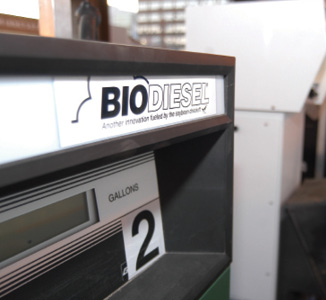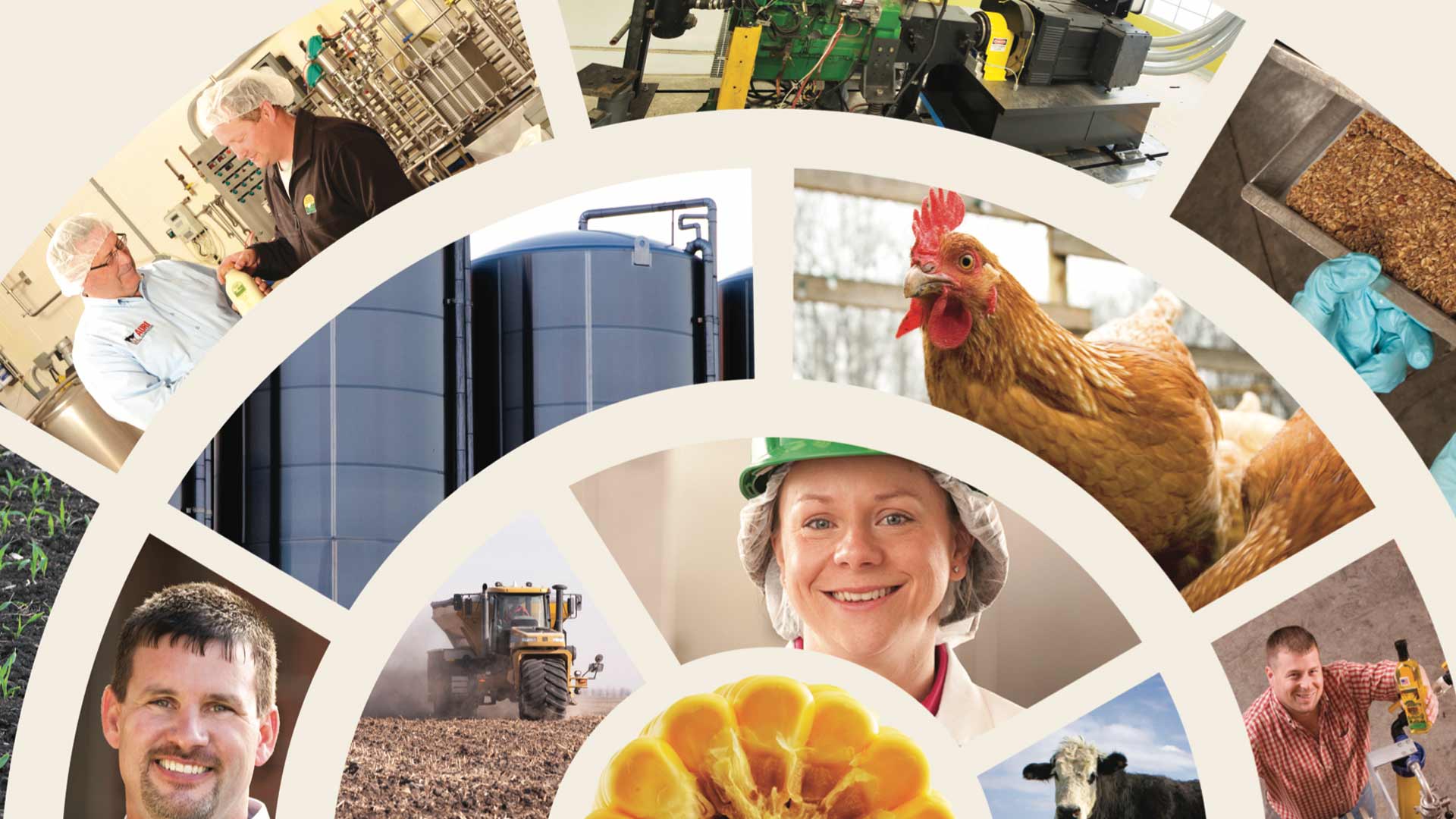–by Liz Morrison
photos by Rolf Hagberg
Start with good ideas. Research their commercial potential. Get that research into the hands of entrepreneurs who can run with it. Follow up with hands-on technical assistance to bring innovations to market.
For 25 years, this has been AURI’s approach to commercializing new value-added agricultural products.
It starts with the “initiative” phase, where new ideas are generated and tested. Each year, AURI organizes more than 50 meetings with Minnesota farmers and the ag processing industry to identify needs and opportunities in four core areas: food, renewable energy, coproducts and biobased products. “This is one of the things that makes our approach unique,” says Michael Sparby, AURI senior project strategist. It ensures that “we are doing research that addresses real needs and current issues,” adds Al Doering, AURI coproducts scientist.
Promising ideas advance to the applied research stage, which is often done in collaboration with other research partners such as the University of Minnesota. For example, in AURI’s early years, an oversupply of soybean oil, along with growing interest in renewable fuels, offered an opportunity for soybean growers: biodiesel. AURI’s research on biodiesel processing laid the foundation for a new Minnesota industry, now generating over $900 million in economic activity.
In the next phase of development, “dissemination,” AURI puts the applied research results into the hands of entrepreneurs and businesses who can use it. “We don’t want our research just sitting on the shelf,” Sparby says. AURI’s biodiesel processing work, for example, led to a practical handbook on how to build a biodiesel plant. “Lots of people wanted to know how to do it,” says Mike Youngerberg, senior director of field services for Minnesota Soybean. The research not only guided three successful Minnesota ventures, but also “kept some people from making biodiesel investments that weren’t right for them,” Youngerberg says.
In the final phase, “commercialization,” AURI provides contacts with industry experts, plus hands-on technical assistance. Product testing, processing and plant design, materials sourcing and pilot lab access are just a few examples. As Minnesota biodiesel production geared up, for instance, AURI provided quality control expertise when plants didn’t yet have their own specialists.
AURI can come in at any stage of this journey, Sparby says, and is often a partner throughout the entire process. Here are three examples of how AURI helped entrepreneurs take innovations from idea to reality.
 Renewable fuel from soybean oil
Renewable fuel from soybean oil
Product:
Biodiesel, a transportation fuel made primarily from soybean oil
Initiative:
In the early 1990s, a huge glut of soybean oil drove a nearly two-decade-long effort to develop a major new use for low-value soybean oil. Working together, the Minnesota Soybean Growers and AURI laid the groundwork for Minnesota’s biodiesel industry. AURI fats and oils chemist Max Norris and scientists from the University of Minnesota Center for Diesel Research evaluated and refined biodiesel processing technologies.
Dissemination:
AURI and the Minnesota Soybean Growers put together the first practical guide to commercial biodiesel production, called “So You Want to Build a Biodiesel Plant.” The handbook analyzed the economics of biodiesel production and offered guidance on permitting, infrastructure requirements, processing plant design, equipment and feedstock sourcing.
In 2002, the state required diesel fuel sold in Minnesota to contain at least 2 percent biodiesel, creating a market for the renewable fuel. Commercial biodiesel plants were built in Albert Lea, Brewster, and Isanti, Minnesota, with a combined production capacity of about 63 million gallons of fuel. In July 2014, Minnesota became the first state to mandate a 10 percent biodiesel blend.
Commercialization:
In the early days of biodiesel production, fuel quality issues were common. AURI scientists served as technical advisers to plant operators, assisted in setting up a biodiesel “help line,” tested fuel quality and created a quality assurance program.
AURI continues to play an important role in the biodiesel sector, developing and testing new uses for glycerin, a biodiesel coproduct.
 Easy eatin’ soybean meal
Easy eatin’ soybean meal
Product:
NutriVance, a high-protein soybean meal, produced by Protein Resources, LLC, a joint venture of Midwest Ag Enterprises of Marshall, Minnesota, and TechMix of Stewart, Minnesota
Initiative:
Livestock feeders were looking for a high-protein, low-fiber feed to replace expensive fish meal in livestock rations.
Standard soybean meal has large amounts of fiber and carbohydrates, called oligosaccharides, which interfere with digestion in young animals. Low-oligosaccharide soybean meal looked like an attractive replacement for fish meal—if a cheaper method for removing the indigestible fiber and sugars could be developed.
But first, livestock growers and feed suppliers needed to know how low-O soybean meal would perform in livestock diets. AURI and the Minnesota Soybean Growers sponsored three sets of nutrition trials at the University of Minnesota, feeding low-O soybean meal to nursery pigs and turkeys. The results: increased feed efficiency and cost savings in piglet and turkey diets, compared to standard fish meal diets.
Dissemination:
AURI has hosted low-O network meetings around this topic to share information and expand knowledge on the topic. Jim Moline, founder of Midwest Ag Enterprises, looked at the research findings and thought low-O soybean meal would be a good fit for his company, which manufactures specialty feeds for export.
Commercialization:
Working with AURI scientists, Protein Resources developed a cost-competitive, proprietary process to remove the fiber and sugars from soybean meal, leaving a digestible, high-protein feed. The extracted carbohydrates are used in dairy and beef cattle rations. The branded feed, sold as NutriVance Soybean Meal, is marketed domestically and internationally to hog, poultry and aquaculture producers.
 Fertilizer from biomass ash
Fertilizer from biomass ash
Product:
NAFMicro, a biomass ash fertilizer derived from incinerated poultry manure, produced by North American Fertilizer of Benson, Minnnesota
Initiative:
Minnesota’s biomass energy sector produces large amounts of ash from incinerated plant and waste material. The ashes contain nutrients, such as phosphorus, potassium and sulfur. Energy companies needed to know the fertilizer value of the ash they were producing.
AURI sponsored biomass ash fertilizer trials on corn at the University of Minnesota. The field trials found that ashes from two sources—the Corn Plus ethanol plant in Winnebago, Minnesota, and the Fibrominn poultry litter power plant in Benson, Minnesota—were good alternatives to conventional fertilizer.
Better handling methods for powdery ashes were also needed. AURI helped identify an ash granulation process that could be mixed with commercial fertilizer and spread with conventional equipment.
Dissemination:
AURI made the fertilizer trial data available to Minnesota biomass energy producers and also demonstrated the granulizing process. A group of entrepreneurs led by Randy Tersteeg of Olivia, Minnesota, saw a market in central Minnesota for the 110,000 tons of ashes coming out of Benson’s Fibrominn power plant each year.
Commercialization:
AURI helped North American Fertilizer with plant set-up and sponsored additional fertilizer trials to refine rate recommendations for corn and other crops. The biomass ash fertilizer—worth more than $10 million in retail sales—is sold as NAFMicro through Midwest fertilizer suppliers.
